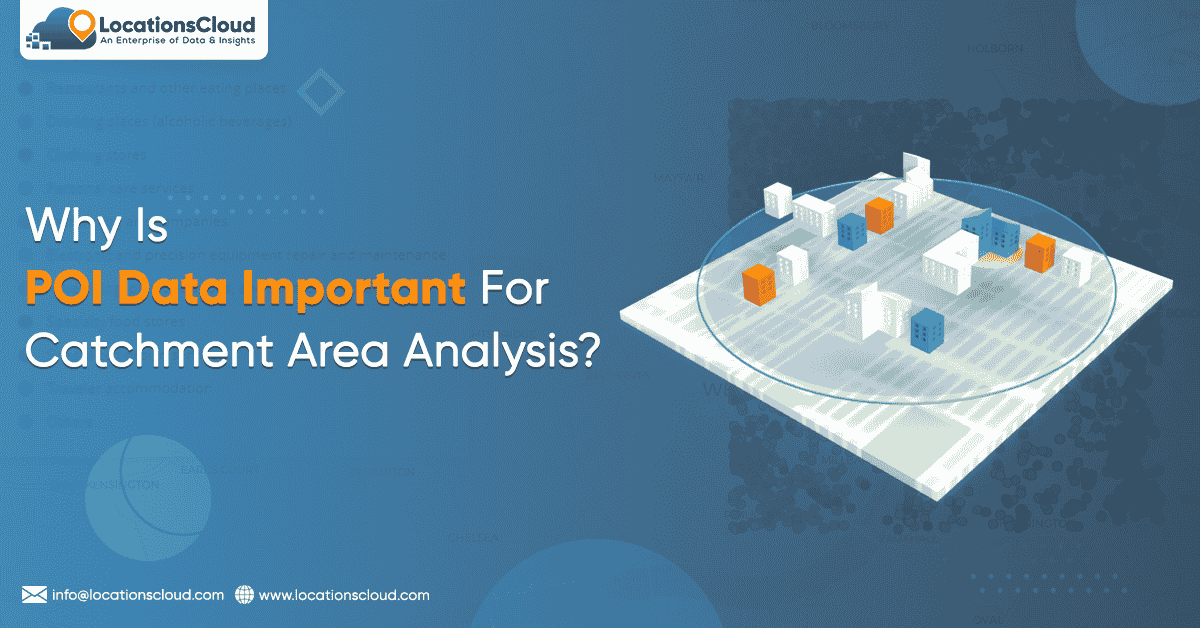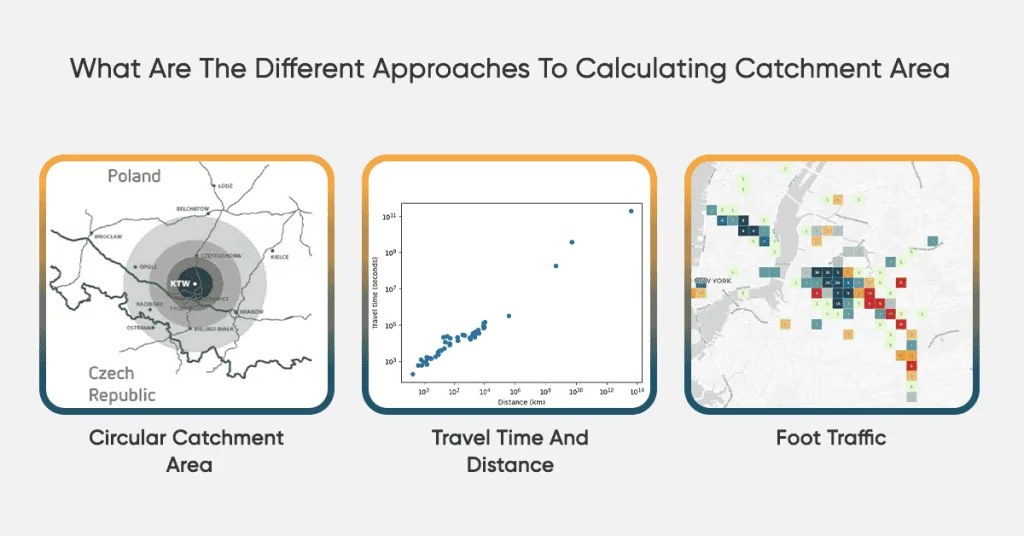
There are over approx. 300 million POI data sets are available to simplify your analysis, but only if you have the right strategies. These strategies could include using POI data to identify high-traffic areas for potential store locations or to analyze competitor locations for strategic positioning. With precise POI (Points of Interest) datasets, businesses gather accurate location and competitor information.
The catchment area has become necessary in understanding business reach and influence based on a particular location. Knowing customers and their interests is essential as a retailer, which helps boost your business’s growth and profits.
This content will outline the importance of analyzing the catchment area using POI data. Various approaches help gain actionable insights on how to gain attention and boost returns effectively.
What Is Catchment Area Analysis?
Catchment area analysis refers to the data from a particular area where a business or service provider gains customers. This is also considered an analysis of the area where people are willing to travel for a specific facility, product, or service.
Some reasons to perform catchment area analysis using POI data for your business locations are:
- Mapping and visualizing where your target audience is visiting the store locations gives you an idea about the service area.
- Get information about the market in the region where your store exists or where you plan to build one to determine if it will meet expectations.
- With catchment area analysis, you can understand gaps and overlaps, which helps improve your business.
- Use POI data to know exactly where your customers travel and prefer to purchase their products.
- This data helps you analyze your competitors, build strategies to beat them and gain business benefits efficiently.
What Are The Different Approaches To Calculating Catchment Area?

There are multiple methods to calculate catchment areas with POI data preferences, which have unique benefits for businesses. Some common approaches are:
Circular Catchment Area
This involves analyzing data using simple methods within a fixed radius around your store location. It is ideal for local businesses wanting to expand in a specific area.
Travel Time And Distance
With advanced POI data gathering tools, you can determine the catchment areas based on the travel time or distance. This will include factors like road networks, traffic patterns, and foot traffic, giving you accurate customer reach.
Foot Traffic
This is a crucial factor in a profitable business and depends on pedestrian activity. This approach helps retailers to locate shops, malls, and other services with high pedestrian traffic.
What Are The Uses Of Poi Datasets In Catchment Area Analysis?
There are multiple use cases of POI data as the products and services grow every minute in the market. Here are some of the essential ones:
- Navigation: It is commonly used in routing systems and applications. This helps customers find particular locations like restaurants, gas stations, tourist attractions, and hotels. Users can optimize the routes smartly by using POI data in the navigation algorithm.
- Market Research: POI data is essential in geographical analysis, as it identifies patterns, gaps, and trends in the market. This will help you evaluate customer behavior and find potential market opportunities to make data-driven decisions.
- Property Evaluation: POI data is valuable for assessing the property before investing to understand the proximity of nearby amenities. As your target consumers have various interests, like schools, parks, hospitals, and transportation, it can be helpful for your business success.
- Clever Advertisement: Advertisers will utilize the POI data to target ads based on customer locations and interests in a specific area.
- Travel: This method is highly beneficial for the travel and tourism industry. It provides information on attractions, accommodations, dining, and other areas that will help you make informed travel decisions.
How Do You Perform Catchment Area Analysis With Poi Data?
From collecting POI data to analyzing it for executing big business decisions, you need to handle the process smoothly using the right resources. A simplified process you can follow is:
Identify The Goals
Whether you want to enter new markets, open a new store, or understand competitor’s strategies, you need clear targets with catchment analysis. With location-based business decisions, you must align the catchment area with the one that best serves you.
Gather POI Data
Rely on ethical measures to gather data from the right resources and avoid extracting sensitive data to avoid legal consequences. Define the resources, platforms, and tools that would help collect data.
Organize The POI Data
Create accurate and informative data for catchment areas with clean and detailed data for analysis. You can use relevant information like purchase history, frequent buyers, and traffic to map the ideal location to succeed in the market.
Conduct The Analysis
It is time to understand customer behavior, find prime locations, and visualize your business from every direction. This will help you scale your business and seize new opportunities based on the catchment analysis results.
Start Executing
Make decisions for your business with successful catchment area analysis that gives you undeniable visualization to beat the competition.
How Do You Use Catchment Area Analysis For Your Business?
Understanding and analyzing the catchment area of business is essential for strategic business decisions and enhancing performance for better returns. Here are things that you can achieve with POI data analysis:
- Customer Insights: Get customer’s behaviors, demographics, and valuable data to deliver personalized solutions.
- Strategic Growth: With data-driven decisions, you can drive sustainable growth with defined, planned expansions.
- Target Marketing: Start pinpointing the locations to customize their strategies for precise marketing campaigns.
- Competition Analysis: Identify the local suppliers and strategize to differentiate yourself in the market and gain customer attention.
- Operational Efficiency: Align your inventory resources with streamlined processes based on local demand patterns.
- Population Check: Gather data about people’s living conditions, household types, job profiles, and other information that helps find your target audience.
What are the strategies to pick a successful location?
With the importance of location in the market, it is crucial to have your strategies aligned. Let us look at some of them:
Demographic Analytics
To target the customers, you need to identify who they are using the right tools and demographic reports to locate areas with a high concentration of your ideal demographic. With POI data extraction, you can determine the age, education level, residence in the household, income, and consumer spending data to access their expenditures. Understand the local spending habits to align your services.
Financial Expenses
When you run a business, it’s essential to take a deep look at the numbers. Gather information about occupancy costs, rent, internet, utilities, taxes, and maintenance. This will help you focus on multiple quotations for comparable spaces and pick the one that aligns with your budget.
Business Accessibility
It is crucial to pick a prominent location that is easier to access and is near major roads. This means having a location with public transportation, parking, nearby residential areas, and attractions. With such POI data, you can easily place your business, which drives customers towards you and boosts sales.
Safety Measures
Assess the neighborhood’s safety and secure necessary permits to avoid legal issues. Gather data on the crime rate and police report for the particular location to ensure you have the right location for your business.
Assess Competitors
Analyze the market to pick the ideal spot for running your business and effectively boosting customer retention. You can consider multiple spots for analysis where you can beat the competition regarding services, marketing, and offers to drive additional foot traffic.
Summing it up!
Getting started with catchment area analysis requires specialized analytics providers and software tools that offer location intelligence and spatial analysis capabilities. It is essential to gain the power of location, customer data, and sales to visualize the data in real-time. The final check of benefits you get by using POI data smartly are:
- Transform bulk amounts of data into actionable analysis and strategies.
- Compare the locations with your competition with detailed reports.
- Make informed decisions for your business and drive it to high-potential customers.
- Identify underperforming stores to make sure you improve your business and deliver a smooth customer experience.
With Location Intelligence, you can combine external geographic and demographic data using the right sources to analyze the dataset. You can use various strategies based on distance, travel time, and other criteria to visualize the distribution within your boundaries. POI data can quickly succeed in catchment area analysis, site selection, operational improvements, or guiding marketing strategies.


